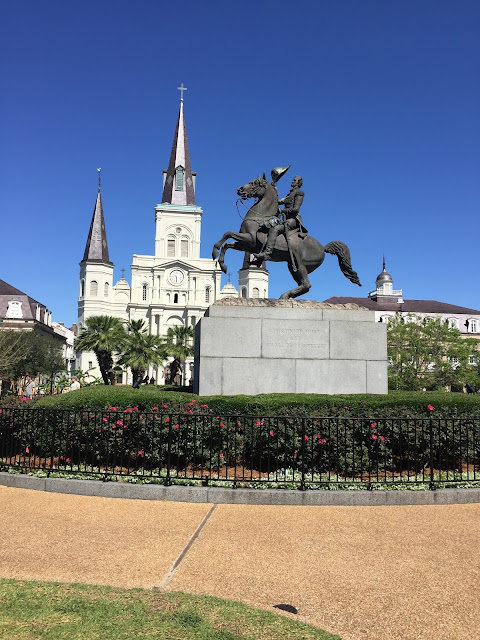Civil Rights Trail - Montgomery Alabama
Montgomery Alabama is considered by many to be the birthplace of the Civil Rights Movement. A walk on the Trail here will take you to a dozen destinations critical for the fight. Some where the movement was planned and conducted. Others like the Southern Poverty Law Center and the Equal Justice Initiative that document the struggle while continuing the work.
Add the fight for the right to vote in Alabama and you have the March from Selma to Montgomery over the Edmund Pettus Bridge. There you revisit Bloody Sunday, Turn Around Tuesday, and finally the 54 mile, 5 day March to the State Capitol.
AIROSMITH spent a week visiting the area and still left leaving some sites unvisited. Our visit here was educational and moving.
 On December 1st, 1955 Rosa Parks refused to give up her seat to a white man on a city bus and was arrested. On December 5th, her day in Court, the Black community chose to boycott the city bus system. They didn’t return for over a year. The entire Black community was involved, organizing car pools and informal taxi services, offering rides to those walking, and just plain walking.
On December 1st, 1955 Rosa Parks refused to give up her seat to a white man on a city bus and was arrested. On December 5th, her day in Court, the Black community chose to boycott the city bus system. They didn’t return for over a year. The entire Black community was involved, organizing car pools and informal taxi services, offering rides to those walking, and just plain walking.
Dr. Martin Luther King Jr. organized the resistance with other community leaders. In response Dr. King’s home, and the homes of other Black ministers, and Black churches were bombed. Those supporting the boycott were attacked and beaten. Eighty nine black citizens, including Dr. King were indicted for conspiracy to interfere with a business. They didn’t wait to be arrested, instead turning themselves in to the authorities all at the same time.
By January 1956 the Supreme Court had ruled that local segregation laws violated the 14th Amendment to the Constitution. Rosa Park’s act of defiance, and the boycott is where, and when the Civil Rights movement began. The Rosa Parks Museum in downtown Montgomery tells the story.
 |
| Dr. Martin Luther King Jr. was the pastor of the Dexter Street Baptist Church from 1954 to 1960. It was from his church that the Boycott and the Movement were planned and organized. |
 In 1960 segregation on public buses was declared unconstitutional. The Southern states ignored the ruling, and the federal government did not enforce the ruling. On May 4, 1961 the Freedom Riders left Washington D.C and headed for New Orleans. The bus was attacked and burned in Anniston, Alabama. Next it was met in Birmingham where riders were beaten by a mob while the police watched. Later that month the bus arrived in Montgomery, where again a violent mob beat the riders, while the police stood by and did nothing. The Greyhound Bus Station in Montgomery has become the Freedom Riders Museum, recounting the history of these rides.
In 1960 segregation on public buses was declared unconstitutional. The Southern states ignored the ruling, and the federal government did not enforce the ruling. On May 4, 1961 the Freedom Riders left Washington D.C and headed for New Orleans. The bus was attacked and burned in Anniston, Alabama. Next it was met in Birmingham where riders were beaten by a mob while the police watched. Later that month the bus arrived in Montgomery, where again a violent mob beat the riders, while the police stood by and did nothing. The Greyhound Bus Station in Montgomery has become the Freedom Riders Museum, recounting the history of these rides. |
| Mug shots of Freedom Riders |
 A final visit for us was the Civil Rights Memorial at the Southern Poverty Law Center. The Memorial was designed by Maya Lin and inspired by he words of Dr. Martin Luther King Jr. The fountain was not working as we had several below freezing nights in Montgomery. That said, the powerful impact of the fountain was not lost.
A final visit for us was the Civil Rights Memorial at the Southern Poverty Law Center. The Memorial was designed by Maya Lin and inspired by he words of Dr. Martin Luther King Jr. The fountain was not working as we had several below freezing nights in Montgomery. That said, the powerful impact of the fountain was not lost. The Orientation Theater streams the film, Apathy is Not an Option where imagery, both past and present, inspires the next generation of social justice advocates.
The Orientation Theater streams the film, Apathy is Not an Option where imagery, both past and present, inspires the next generation of social justice advocates. The March Continues is a hallway running the length of the building which highlights contemporary civil and human rights issues, and shows how each individual can and will make a difference.
The March Continues is a hallway running the length of the building which highlights contemporary civil and human rights issues, and shows how each individual can and will make a difference. Finally you come to the Wall of Justice, and a space for reflection. The wall is a twenty by forty foot display that contains more than a half million names continuously scrolling like falling waters. Each name is added by a visitor who has made a personal commitment to work for justice in their lifetime.
Finally you come to the Wall of Justice, and a space for reflection. The wall is a twenty by forty foot display that contains more than a half million names continuously scrolling like falling waters. Each name is added by a visitor who has made a personal commitment to work for justice in their lifetime.
























Comments
Post a Comment